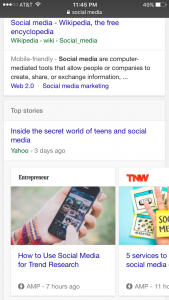
Image courtesy of Bench Accounting via Unsplash
Things are never boring in the realm of search engine marketing. When it comes to search engine optimization for Google, in particular, you just never know what will happen from one day to the next. Throughout the 4th quarter of 2015, the tech and marketing industries were buzzing with speculation over proposed algorithm updates, anticipated features, and the general behavior of Googlers around the globe. Those expected changes came earlier than we thought they would, and search engine marketers everywhere are wondering what could possibly happen next.
Back in January, we learned that the infamous Panda (a search filter that prevents low-quality sites from winning in the search engine results pages) had officially become part of Google’s core ranking algorithm. This changes things for a lot of webmasters, because historically, Panda updates were predictable and independent of core updates. It also means that every single time you search for something on Google, it will be subjected to Panda. That’s not something that web experts are accustomed to; it’s going to require some adjustment.
According to our industry’s leaders, other changes to Google’s core ranking algorithm seem to be related to:
- Chronology – How recent are your posts?
- Details – How much information are you providing to your readers?
- Visuals – Have you included images and videos?
While those core updates are obviously the reason for all of this search marketing upheaval, there are a few other points that we want our readers to know about. Google has been busy, so you may want to take some notes!
Accelerated Mobile Pages Steal the Show
You have surely seen “AMP” mentioned in your newsfeed. This is a Google-backed project, which stands for “Accelerated Mobile Pages”. This, too, was rolled out earlier than anyone anticipated, and now news-based websites that are using AMP are being given priority in the results that appear when someone performs a search on a mobile device.
The evidence of this change can be seen if you use your phone or tablet to search something that you know is newsworthy. We searched for “social media” and in the image to the right, you will see that there are two types of results for the news feed. First, you have the list-style results that you are used to seeing, and then you will see the news carousel. Notice the “AMP” icon on each of those carousel items. You can be sure that you’ll be seeing a lot more of that in the future.
Four Ads are Better (for Advertisers)
Just when you thought search engine optimization couldn’t possibly get more cutthroat, Google alters its ad layout. In recent years, organic search results (the ones you work so hard for) appeared with ads in a right sidebar, as well as directly below the search bar.
In what appears to be an effort to give its advertisers a boost, that sidebar is being eliminated and the ads that appear above organic results are growing. That is, additional overhead ads are taking up space that was once allocated toward websites just like yours. That eye-level organic spot #1 is no more. There is an ad there now, which has pushed all of the other results down. For some businesses, that means being pushed to the next page (something that can have a huge impact on revenue).
All of this leaves you with only a few remaining options: become an SEO superstar, invest in Google pay-per-click ads, or win at the local listings.

Image © SunnysideSocialMedia.com
Google My Business for Local Listings
Google has given business owners and marketers more control over local listings than ever before. This is the key to SEO for most local businesses with a physical address. The reason for that is the placement of local listings. Because they appear above the fold and are featured first for searchers, these placements have now become prime real estate.
As paid ads continue to push our organic results down and onto the next page, you can expect to see more business owners competing for those coveted local rankings. Your best shot at winning one of those top spots is through Google My Business, the combination “master dashboard” for Google Plus, Google Maps and Google Search. Google’s rollout of this admin panel has left many business owners feeling overwhelmed and bewildered, so if you’re feeling that way, know that you are not alone.
For anyone who does not handle these details daily, most aspects of search engine optimization are confusing. Whether you are dealing with paid search results, local SEO, or organic ranking, it will always be in your best interest to speak with an expert. If you would like to learn more about search engine marketing for your own website, contact a member of the SunnySide team today. We welcome the opportunity to help your business grow.
